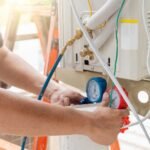A well-maintained hot tub can deliver 10 to 15 years of reliable performance, offering comfort, relaxation, and health benefits long after the purchase. However, achieving this lifespan requires consistent maintenance and informed care. Neglecting regular upkeep often leads to high repair costs, reduced efficiency, and even early equipment failure. This guide outlines key maintenance strategies to extend the life and performance of your hot tub, whether it’s used in a private home, a rental property, or a commercial wellness space.
1. Establishing a Consistent Cleaning Routine
A structured cleaning schedule prevents the buildup of bacteria, algae, and mineral residue. Water in a hot tub circulates through jets, filters, and plumbing lines, which can trap organic matter over time. Follow these best practices:
- Weekly Tasks:
- Test and adjust the pH, alkalinity, and sanitizer levels.
- Wipe the waterline to remove oils, dirt, and residue.
- Clean the filters by rinsing with a garden hose.
- Monthly Tasks:
- Deep clean the filters using a specialized cleaner to remove calcium and oil buildup.
- Inspect the jets for debris and mineral accumulation.
- Quarterly Tasks:
- Drain and refill the tub to refresh the water and rebalance minerals.
- Sanitize the shell with a mild, non-abrasive cleaner to prevent surface damage.
- Flush plumbing lines with a biofilm remover before refilling.
These steps prevent bacterial growth, maintain water clarity, and reduce strain on the pump and heating elements.
2. Monitoring and Balancing Water Chemistry
The water’s chemical balance directly affects the durability of your hot tub components. Imbalanced water corrodes metal parts, degrades seals, and irritates skin. The goal is to maintain balanced levels of pH, alkalinity, calcium hardness, and sanitizer.
- pH Level:Keep between 7.2 and 7.8. Low pH increases corrosion risk, while high pH promotes scale buildup.
- Alkalinity:Maintain 80–120 ppm to stabilize pH and prevent sudden shifts.
- Calcium Hardness:Stay within 150–250 ppm. Too low causes foaming and corrosion; too high leads to scale.
- Sanitizers:Chlorine or bromine should stay within recommended levels to control bacteria and viruses.
For convenience, most owners rely on digital test strips or smart monitoring systems. When chemical levels fluctuate often, consult a local hot tub store that sells professional-grade balancing kits and offers guidance on proper usage.
Proper chemical management not only preserves components but also keeps energy consumption low by allowing the heater and jets to function efficiently.
3. Protecting the Cover and Exterior

The hot tub cover protects against debris, heat loss, and UV damage. Without proper care, it can absorb moisture, crack, or lose insulation value.
- Clean the Cover Regularly:Use mild soap and water every two weeks to remove dirt and prevent mildew. Avoid harsh chemicals that degrade vinyl.
- Condition the Vinyl:Apply a UV protectant monthly to prevent fading and cracking.
- Check for Waterlogging:A heavy or sagging cover indicates internal foam saturation, reducing insulation. Replace it if it becomes difficult to lift or shows signs of mold.
- Secure the Cover:Wind straps prevent the cover from blowing off in bad weather, protecting both the tub and surroundings.
For the exterior cabinet, clean it with non-abrasive products and periodically inspect for cracks or fading. Wooden cabinets should be resealed annually, while composite materials only need gentle washing.
4. Managing Filtration and Circulation Systems
The circulation system plays a crucial role in keeping water clean and evenly heated. Inadequate filtration leads to cloudy water and damages pumps over time.
- Filter Maintenance:Replace filters every 12 to 18 months, even with regular cleaning. Dirty filters restrict flow and cause the pump to work harder.
- Run the Circulation Cycle:Many models allow continuous low-speed circulation, but for those that don’t, run the jets for 15–20 minutes twice daily to move water through the filters.
- Inspect for Airlocks:If jets lose power after draining and refilling, an airlock may block the pump. Bleed the system as instructed in the manufacturer’s guide.
- Winterization:In cold regions of the USA and Canada, either maintain constant operation or winterize the system by draining it, blowing out the lines, and using antifreeze designed for spas.
An efficient filtration and circulation system reduces electricity use and ensures consistent heating performance, which directly affects comfort and operating costs.
5. Routine Equipment Inspections and Professional Servicing
Even with excellent care, mechanical parts wear out. Scheduling regular professional inspections can prevent small problems from turning into costly failures.
- Pump and Heater Checks:Look for unusual noises, reduced pressure, or temperature inconsistencies. These indicate bearing or element issues.
- Seal and Gasket Inspection:Cracked or deteriorated seals can cause leaks, leading to wood rot or electrical damage.
- Electrical Safety:A technician should test the ground fault circuit interrupter (GFCI) and wiring annually.
- Jet Performance:Jets that sputter or stop working often have mineral buildup; cleaning or replacement restores full pressure.
Routine service every 12 to 18 months ensures that electrical and hydraulic systems remain in optimal condition, particularly in regions with hard water or high mineral content.
6. Energy Efficiency and Smart Upgrades
Improving energy efficiency extends the lifespan of components by reducing operational strain. Consider these upgrades and habits:
- Insulated Covers:Modern double-layer covers improve heat retention by up to 25 percent.
- Energy-Saving Pumps:Variable-speed pumps adjust flow rates automatically, minimizing wear and power use.
- LED Lighting and Timers:Replacing halogen bulbs and scheduling cycles reduces unnecessary energy draw.
- Thermal Blankets:Floating thermal blankets beneath the main cover retain heat overnight.
Regular monitoring of energy bills can reveal early signs of performance decline. A sudden increase may indicate heater inefficiency, scale buildup, or leaks.
7. Seasonal and Long-Term Storage

If you close your hot tub for a season, proper storage prevents damage from freezing or stagnation.
- Drain Completely:Remove all water from plumbing lines, heater, and pumps.
- Clean and Dry Surfaces:Apply a protective cleaner to the shell and cover.
- Use Antifreeze:Add spa-grade antifreeze to lines to prevent cracking in cold climates.
- Store Indoors if Possible:For portable spas, store indoors or under a covered structure.
When reopening, flush the system with a cleaning solution before refilling. Inspect all connections and test components for leaks before restoring power.
Hot tub longevity depends on preventive maintenance and smart operation. Routine cleaning, balanced chemistry, and equipment inspections significantly reduce repair frequency and energy costs. Whether you use your hot tub in the United States or Canada, these strategies provide both efficiency and peace of mind, ensuring years of safe and enjoyable soaking.
















